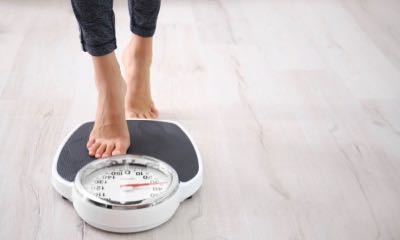Your Body Composition Shapes Your Health
Humans are 99.5 percent the same, at least genetically. The other 0.5 percent of your DNA, combined with lifestyle choices and circumstances, determines the extent to which you are physically different. Many differences are inconsequential and unrelated to health. They include hair, eye, and skin color, as well as your height. Other differences are tied to body composition—like body fat, bone density, and muscle mass—and can have a direct impact on your health and lifespan.
Too much emphasis is put on body weight in relation to health, when in reality health and lifespan are linked more closely to body composition. Does the number on the scale matter? Yes, but the composition of that body weight is most important to overall health.
In very simple terms, your body’s two major components are fat mass and lean mass (muscles, bones, organs, and water). The distribution of these two types of body mass mean so much to your health. Understanding how your body composition impacts you and learning how to optimize it will help you forget all about the number on the scale.
Defining Body Composition
There are several ways to describe the composition of the human body. For example, body composition can be expressed in terms of chemicals:
- Water
- Proteins
- Fats
- Carbohydrates (like glucose)
- Genetic material (DNA)
- Vitamins and minerals
- Gases (like oxygen, carbon dioxide, and hydrogen)
Body composition can also be evaluated as tissues or other types of material. This includes muscle, fat, bones and teeth, nerve tissue, body fluids, connective tissue, and air in the lungs.
When the concern is health and fitness, body composition typically describes the percentages of water, fat, bone, and muscle. These are the body components over which you have the most control and can make the greatest impact on your daily health.
Body Composition vs. Other Body Measurements
A quick check of your health or fitness progress often includes stepping on a scale to get your weight. It isn’t without benefit, but the number doesn’t say much about your health.
Body Mass Index (BMI) is another way to analyze health. Your height and weight are considered, which makes it slightly more accurate in determining health status. But BMI is still comparing how heavy you are to a standard. And, that standard may not fit your individual goals.
Like the number on the scale, the BMI doesn’t distinguish between muscle and fat or tell you anything specific about your body tissues. People with the same BMI could have drastically different body types and fitness levels. But knowing the make-up of your body is helpful for understanding your current health, setting health goals, and monitoring progress.
General Composition of the Human Body
Along with giving you shape, your body tissues have different functions and roles, affecting your health in different ways. Knowing what you’re made of may explain a lot about your current health and help direct your wellness efforts.
Water is generally the largest portion of the body, accounting for about 60 percent of total weight. In an average 70 kg (about 150 pounds) person, that amounts to about 40 liters of water. Of the remaining 40 percent of body weight, the adult skeleton accounts for about 7-15 percent. The rest is muscle and fat, which vary considerably between individuals.
Let’s take a closer look at how each of the four components influence your body composition and health.
Part 1: Fluids and Total Body Water
Total body water (TBW) is all the water contained throughout your tissues, blood, bones, and various fluid compartments. TBW is a significant fraction of the body both by weight and volume.
The average adult male’s weight is approximately 60 percent water. The number for an average adult female is about 55 percent. Age, health, water intake, gender, and body fat can significantly influence total body water. The body of a newborn infant can be as much as 93 percent water and a very obese adult can have as little as 15 percent water.
This large variation is due to the difference in body fat tissue, which retains less water than lean tissue. About 75 percent of the body’s water content is found in muscles. Fat accounts for only about 10 percent. Water not contained in the muscle and fat is part of various body fluids (like blood), inside organs, gastrointestinal tract, the eyes, and elsewhere. About two thirds of the body’s water is located within cells.
Part 2: Body Fat (Adipose Tissue)
There are two major types of adipose tissue: white and brown. For the purposes of this article—and in general when discussing body fat—white adipose tissue is what’s referred to as fat. That’s because brown adipose tissue makes up only about five percent of the fat tissue in a newborn. And that number decreases significantly with age. Its primary function is to generate body heat.
The primary role of fat is to store energy. But fat also plays an important role in protecting and insulating the body and its organs. Until recently, fat was thought of as an inactive storage site for energy. Body fat is far from inert, though.
Fat cells produce hunger-related hormones (like leptin), sex hormones (like estrogen), cell signaling molecules called cytokines, and a fat-specific hormone called resistin. This hormone has been linked to insulin resistance, obesity, and diabetes. Because of these important functions, fat is now considered an endocrine organ.
And when it comes to health, there are three things to remember about fat: location, location, location. Where fat is stored makes all the difference. It is better for your health to be pear-shaped (fat stored in the hips and thighs) than apple-shaped (high percentage of abdominal fat). Take a look at the different places fat accumulates.
- Belly Fat or Visceral Fat
Fat that surrounds the abdomen and is packed between organs is known as visceral fat. But it’s more commonly referred to as belly or abdominal fat. An excess of visceral fat results in a protruding belly, and infiltrates the abdominal cavity and the body’s organs. This visceral fat, much of which is hidden within the abdomen, is most closely linked to obesity-related disease and health conditions. Many studies have suggested visceral fat can predict disease risk and life expectancy more accurately than BMI or waist circumference.
Sex hormones have a large influence on the storage location of body fat. That’s why males are more likely than females to store fat in the abdomen. Female sex hormones direct fat to be deposited primarily in the buttocks, hips, and thighs. When estrogen declines, excess energy is stored mostly in the belly.
- Subcutaneous fat
Subcutaneous fat is located just below the surface of the skin. It provides insulation, protection, and a reserve of energy. This fat is located throughout the body in the limbs, hips, and buttocks but is not significantly related to most obesity-related health conditions.
It does increase the burden on the circulatory system, as each pound of fat requires approximately a mile of new blood vessels. In addition, subcutaneous fat is metabolically active (less so than visceral fat) and secretes hormones, like leptin and resistin. The release of these hormones increases with the level of body fat. And since they influence appetite and insulin resistance, these hormones can certainly complicate your intention to lose weight or get into better shape.
- Intramuscular Fat
The majority of body fat is located in the abdomen and under the skin, but there is another location that can impact your health. Fat stored within muscle itself is known as intramuscular fat. It’s not necessarily a bad thing. It’s an important source of energy that can be used during exercise. But like most things, a little is good and a lot is bad. Too much intramuscular fat can lead to increased insulin resistance and obesity-related health conditions.
Part 3: Muscle
Your body has three different types of muscle: skeletal, smooth, and cardiac. But skeletal muscle is the only type significantly influenced by exercise and diet. Unless otherwise stated, discussion of muscle refers to skeletal muscle.
Skeletal muscles work the skeletal system, support movement, posture, balance, and actions like chewing and swallowing. Skeletal muscle gives you broad shoulders, strong arms, or toned legs. But skeletal muscle isn’t all about physical size and strength.
Muscle holds a valuable source of energy stored in the form of carbohydrate (glycogen), which is made available when the body needs sugar (glucose) for energy. It’s also an important source of amino acids that support protein synthesis and energy production when dietary and other resources are depleted or unavailable. This storage role is increasingly important in times of high stress and when supplies are too low (during starvation). Age-related muscle loss greater than normal can decrease the quality of life in many ways and leave the elderly at a higher risk of poor health and disease.
The other two muscle types are under involuntary control. Smooth muscle lines the walls of blood vessels and digestive organs. Cardiac muscle makes up the bulk of the heart, and is responsible for the life-long rhythmic contractions of one of the body’s most vital organs. You may not have as much direct influence on smooth and cardiac muscle, but your diet and lifestyle do influence the function and health of these vital and unseen muscles.
Part 4: Bone
Bones are more than a structural framework that also protect vital organs. They’re living tissue that play many roles in health.
Bones contain nerves and blood vessels, and marrow is the site of red-blood-cell creation. Perhaps bones’ most important function—as it relates to body composition—is as storage for minerals. That’s mainly calcium, phosphorus, and magnesium. When needed, these minerals can be released from bone to help buffer the pH of the body and maintain acid-base balance.
About 80 percent of adult bone mass is the hard, durable outer layer known as cortical, or compact bone. The interior is filled with a spongy network of tissue called cancellous bone, but is also referred to as spongy or trabecular bone. It’s less dense and more flexible than cortical bone, and contains blood vessels, fat, and marrow.
Since bones are living tissue, they need constant nourishment and maintenance. Bone anatomy and function is complex, but the thing you need to know is your diet and lifestyle directly impact the density, strength, and function of your bone.
Why Body Composition Matters
Obesity rates around the world have been rising for years. And there is near universal agreement that excessive body fat is a serious risk to health and lifespan. That’s because numerous health problems are related to excess body fat and obesity.
The current obesity epidemic highlights the importance of knowing and understanding your body composition. Whether it’s too much body fat, too little muscle, low bone density, or a combination of each, body composition can significantly impact your short- and long-term health.
Health complications related to excess body fat are well established and commonly understood. That makes it tempting to assume that it’s healthiest to have as little body fat as possible. However, having too little body fat, has its own complications. It’s also possible to be overfat and underweight. Being lean, on the other hand, represents a healthier ratio of muscle to fat and better illustrates a healthy body type.
When it comes to health and nutrition, the importance of balance cannot be overstated. The same principle applies to body composition. Variations within and between individuals are of little consequence to health when they are within normal ranges, but extremes on either end of the spectrum can significantly increase the risk of health problems.
Some complications associated with unbalanced body composition include:
Excess Body Fat/Obesity
- Shorter lifespan
- Cardiovascular disease and impaired heart function
- High blood pressure
- Glucose dysregulation and Diabetes
- Gallbladder disorders
- Non-alcoholic fatty liver disease
- Increased risk of various types of cancer
- Osteoarthritis and back pain
- Obstructive sleep apnea
- Various complications in pregnancy
- Menstrual abnormalities
- Shortness of breath and other respiratory disorders
- Compromised immune function
- Increased stress levels
Low/Insufficient Body Fat
- Low body insulation
- Minimal energy reserves
- Inadequate cushioning for organs
- Decreased cardiovascular function
- Depressed immune health
- Impaired ability to recover from exercise and illness
- Diminished testosterone levels
- Menstrual abnormalities, amenorrhea
Low Muscle Mass
- Increased risk of frailty and poor balance
- Insulin resistance and poor glycemic control
- Increased risk of metabolic disorders
- Poor bone health
- Disruption in normal hormone functions
- Decrease in strength
- Increased susceptibility to hospitalization
What is a Healthy Body Composition?
The best body composition for you depends on several things. But body fat percentage usually takes center stage. That’s because it’s the easiest to manipulate and has the greatest influence on health. Aside from feeling healthy and vital, a minimal level of body fat is necessary to maintain life and reproductive functions.
Your ideal body fat percentage depends on your gender and your fitness level and goals. For example, females require a slightly higher percentage of body fat than men, mostly for reasons of childbearing and maintenance of reproductive hormones. Based on guidelines from the American Council on Exercise, the table below provides the ranges of body fat that best represent fitness level and gender.
| Percent Body Fat Definitions for Men and Women | ||
| Description | Men | Women |
| Minimum Essential Fat | 2-5% | 10-13% |
| Elite Athletes | 6-13% | 14-20% |
| Healthy and Fit | 14-17% | 21-24% |
| Acceptable | 18-24% | 25-31% |
| Obese | >25% | >32% |
How to Analyze Body Composition
Body composition analysis gives you a snapshot of your health. A variety of methods describe the make-up of the body, differentiating between fat, protein, bone and minerals, and body water. Approaches vary from quick and simple estimates to complex and highly accurate results. Some methods require a health professional or experienced practitioner to perform the analysis and interpret the results.
Here is a short summary of the most common methods of body composition analysis to help you decide the best fit for you.
- Skinfold Thickness (Calipers): The most commonly used method measures subcutaneous fat by pinching the skin and using a caliper device to measure the thickness of the skin fold in several sites on the body. The chest, arms, abdominals, and thighs are usually measured, although some protocols may include as many as seven different parts of the body. The caliper measurements are then plugged into a formula used to estimate body composition. This method is quick, accessible, and inexpensive. But it’s limited in its ability to accurately portray total body composition since it only measures subcutaneous fat.
- Bioelectrical Impedance Analysis (BIA): This method uses electrical impulses to determine the level of lean body mass. Machines used for BIA range from simple home scales with electrodes under each foot, to more complex, elaborate devices with electrodes for hands, feet, and other parts of the body. BIA works on the principle that water is a good conductor of electricity. The devices send tiny electrical impulses through the body and measure how quickly they return. Since lean tissue has a much higher water content than fatty tissue, lean body mass can be estimated based on the speed of the electrical impulses throughout the body. BIA is quick, safe, and doesn’t require any expertise. It does, however, rely on certain assumptions (ie. percent of body water) that limit its accuracy.
- Hydrodensitometry (Underwater weighing): First, your weight is taken outside the water on a scale. Then, your weight is determined while fully submerged underwater. Because lean tissue is denser than fatty tissue, the difference in the two weights can be used to determine the density of your body. That measurement can then be used to estimate your body composition. The accuracy and reliability of this method is good, but accessibility and convenience can be a negative.
- Air Displacement Plethysmograph (ADP): The method of using air displacement to assess body composition is a more recent advancement. Using a similar principle to underwater weighing, a machine called the Bod Pod measures body weight and air displacement to determine body density. Body composition is then calculated and stated as a percentage of lean body mass and fat mass. It’s quick, safe, and accurate, but requires access to a machine and an experienced clinician.
- DEXA (Dual-Energy X-Ray Absorptiometry): If you’ve had a bone density test in the past several years, you may already be familiar with a DEXA machine. But they can be used for more than bone density scans. Using X-ray beams, DEXA machines can determine bone mineral density, lean body mass, and fat mass. It’s the gold standard for measuring bone density, but it is also very accurate in determining the composition of other body tissues. It can also measure the status and change in specific parts of the body. But it does require expensive equipment and results in exposure to small amounts of radiation.
- Ultrasound: This method has been used to accurately assess body fat and tissue composition for over 50 years. The portable machine is capable of making fast regional estimates of body composition. It is used most often in research situations because it is reliable, accurate, and reproducible.
- Magnetic Resonance Imaging (MRI): Strong magnetic fields and radio waves are used, in concert with your body’s own natural magnetic properties, to produce detailed images of the inside of the body. MRIs can analyze a range of different fat and muscle tissues with high precision, including individual muscles. This method can differentiate different types of fat and muscle, and determine the volume of fat within organs and muscles. MRIs are highly accurate, but for the purposes of body composition analysis would only be used in clinical or research settings.
No single method is best for everyone. They all have advantages and limitations. Working with your health professional, trainer, or clinician will help you determine which method is best for you based on your health status, fitness goals, and the practicality of the method. But the following table recaps the characteristics of selected body composition assessment methods.
Measurement Methods Table
| Method | What is Measured | Pros | Cons |
| Skinfold thickness | Thickness of subcutaneous fat in various sites of the body | Inexpensive, non-invasive. Reliable and useful for measuring body fats in specific regions of the body. | Use is limited to moderately overweight and thin subjects.
Accuracy and reliability can vary, depending on the skill of the technician and the brand of caliper. Estimate regional fatness, but doesn’t give an accurate representation of body composition. |
| Bioelectrical Impedance Analysis (BIA) | Total body water (TBW) which is converted to fat free mass (FFM) | Inexpensive, safe, quick, and require little-to-no technical expertise.
Good for monitoring changes within individuals over time. |
Because it assumes a typical body water content, validity is best in young, healthy, and normally hydrated adults.
Accuracy can be influence by disease states and tends to overestimate lean mass in obese individuals. |
| Hydrodensitometry (also called hydrostatic weighing or underwater weighing) | Body weight on land and under water, body volume, body density, and residual lung volume | Reliable and consistent in determining body density with long history of use in clinical settings and sports. | Not easily accessible. Residual lung volume can influence its accuracy. The density of lean mass is an assumed constant, but varies with age, sex, and fitness level. |
| Air Displacement Plethysmography (ADP), BOD POD | Total body volume, lean mass, and fat mass | Accuracy similar to underwater weighing, but easier to perform.
Reliable for assessing body fat and body density. |
Expensive machine and not easily accessible.
Can overestimate fat mass. Health conditions and disease states can reduce accuracy. Clothing and facial/body hair can alter results. |
| Dual Energy X-ray Absorptiometry (DEXA) | Total and regional body fat, lean mass, and bone mineral density | Highly accurate and reproducible. Can determine body composition in specific body regions. Gold standard for analyzing bone density. | Expensive equipment required. Small amount of radiation exposure. |
Changing Your Body Composition in a Positive Way
Nothing has greater influence on your body composition than your diet. This is especially true of body fat because it’s a matter of energy balance. You’re either storing fat or using it for energy to perform activities. Understanding your energy needs and knowing the appropriate range of calories you need to consume for your ideal weight is a good place to start.
In addition to consuming an appropriate amount of food, what you eat is also important. Acquiring adequate amounts of quality protein, and a wide variety of colorful and fiber-rich fruits, vegetables, and whole grains will also impact your body composition and health.
Focusing solely on diet or exercise to lose weight or stay healthy might not be the answer. Combining consistent exercise with a healthy diet can help propel you to a healthy weight and achieve a body composition right for you.
Ideal body composition is not just about weight or the level of body fat. Training to improve muscle size and strength is another way to improve body composition and positively alter the ratio of lean body mass to body fat. Whether you choose to focus on cardio-type exercises, emphasize strength training, or combined both, it’s most important to find a routine that you enjoy and promotes consistency.
There’s no doubt diet and exercise have the greatest impact on body composition, but there are other factors to consider. Genetics, current or past health conditions, quality of sleep, and stress management can all influence body composition.
Start Changing Your Body Composition Today
Lifelong health and wellness is most often a matter of balance. This is also the case with your diet, exercise, and physical body itself. Overwhelming scientific evidence shows that a healthy body composition represents a balance between fat and muscle, as well as sturdy bones and good hydration.
Instead of focusing solely on weight, challenge yourself to make improvements to your body composition. Even small changes for the better can improve many aspects of your health. Chances are good you will move easier, sleep better, and be in a better mood.
If you’re not sure where to start, check with your health or fitness professional about the healthiest ways for you to eat better and incorporate physical activity. This is especially important if you haven’t been active for a while.
From now on, when you think about fitness, focus on “shape” rather than weight. It provides a better picture of your actual health. And it’s more likely to increase your “healthspan” as well as your lifespan.
References
https://www.encyclopedia.com/medicine/encyclopedias-almanacs-transcripts-and-maps/composition-body
https://bionumbers.hms.harvard.edu/files/Chemical%20Composition%20of%20Adult%20Human%20Body.pdf
https://www.ncbi.nlm.nih.gov/books/NBK278973/
https://www.medicalnewstoday.com/articles/320444.php#Function
https://www.bcm.edu/bodycomplab/bpodtheorypage.htm
https://dailyburn.com/life/health/how-to-measure-body-fat-percentage/
https://www.hsph.harvard.edu/nutritionsource/an-epidemic-of-obesity/



















